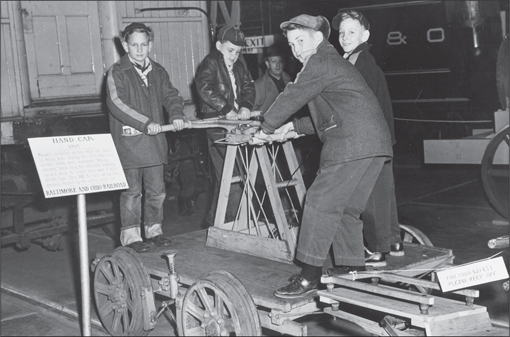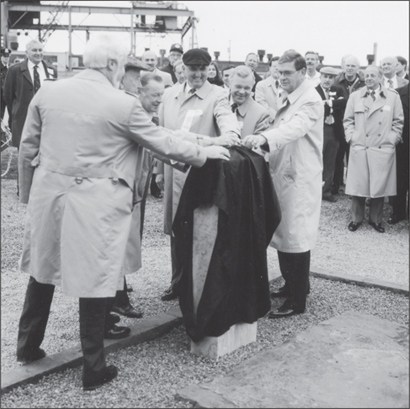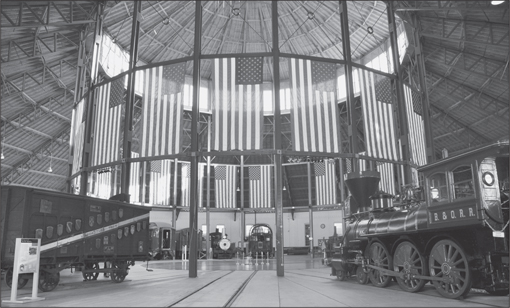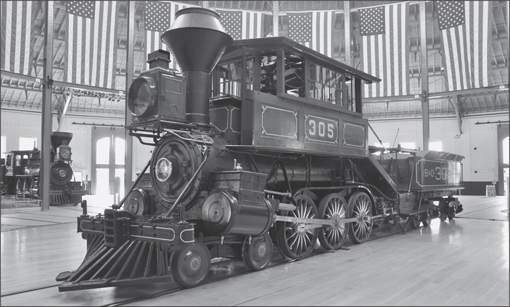Eight
THE B&O
RAILROAD MUSEUM
1953–TODAY
The B&O Railroad Museum exists on the hallowed grounds of the B&O’s Mount Clare Shops. Widely recognized as the birthplace of American railroading, it consists of five historic buildings on 40 acres in west Baltimore. The museum contains the oldest and most comprehensive collection of railroad artifacts, locomotives, and rolling stock from the beginning of US railroading through today.
The gem of the B&O Railroad Museum is the 1884 passenger car roundhouse, which opened as the Baltimore & Ohio Transportation Museum on July 4, 1953. The core of the collection on display in the roundhouse can be traced to the late-19th-century efforts of “Major” Joseph Pangborn, hired in 1880 to promote the railroad. He saved many aging locomotives for exhibit at the World’s Columbian Exposition in Chicago in 1892–1893 and the 1904 Louisiana Purchase Exposition in St. Louis. The success of these exhibitions led the railroad to save and store its collection in Martinsburg, West Virginia. They would be displayed again in 1927, during the 100th anniversary celebration of the B&O known as the Fair of the Iron Horse. The fair’s site was intended to become a museum; however, the Great Depression and a severe storm devastated the grounds.
Many of the historic locomotives and rolling stock were kept in storage until 1953, when the B&O Railroad placed them on display at the newly opened museum with great fanfare. It faced a difficult future due to financial issues associated with the decline of the B&O. Ultimately, mergers would force the end of the B&O in 1987. However, efforts of dedicated corporate officials, like the Chessie System’s Hays T. Watkins and then Baltimore mayor William Donald Schaefer, ensured its survival. In 1990, CSX, the ultimate successor of the B&O, cut ties with the museum, which began operation as a nonprofit.
Today, the museum continues to collect, preserve, and present the history of American railroading, with an emphasis on the B&O, C&O, Western Maryland, and other mid-Atlantic railroads. It is a National Historic Landmark, a Smithsonian Institute affiliate, and an award-winning educational institution. Dedicated to bringing history alive, it continues to be a national treasure.

Members of the Women’s Passenger Association gather at the historic first stone during their visit to the B&O Railroad Museum in September 1957. The group’s visit was highlighted in the employee magazine, as local B&O employees led the tour on an evening that featured dinner at the Lord Baltimore Hotel, a discussion on the B&O’s historic train fabrics, and ended with a tour of the museum.

Lawrence Sagle, B&O public relations representative and curator of the B&O Transportation Museum, is interviewed by Mac Edwards on local Baltimore station WJZ-TV in October 1957. The Imlay coach Ohio serves as the backdrop for a segment featuring the museum’s exhibits. The Imlay cars were reproductions of some of the earliest passenger cars used on the railroad.

Visitors enjoy the museum’s HO-scale model train layout, located on the upper floor of the annex. Designed by Lawrence Sagle, it was built in 1956 by Ken Henry, Emil Elliott, Bill Sakers, and George Baldwin. It contained a small town, a portion based on the B&O’s main line near the famed Magnolia cut-off, and a section with train-service facilities. The layout was removed from display in 2003.

The William Mason sits on the turntable in these undated images inside the museum’s roundhouse. The roundhouse has always been used to house the most significant pieces in the museum’s collection and contains the most extensive collection of 19th-century locomotives and rolling stock dating to the beginning of railroading. Built in 1856, the William Mason is an “American-type” locomotive and is the oldest operating steam engine in the country.

Charlie Carroll cleans the No. 600 JC Davis at the B&O Railroad Museum in 1957. Built in 1875, the engine was designed by J.C. Davis, the B&O’s master of machinery. Due to the power and success of the railroad industry, these locomotives were known as “moguls.” Originally, the moguls were designed for freight service; however, Davis also decided to use the powerful and versatile locomotives for passenger service. During the nation’s centennial in Philadelphia, the No. 600 was exhibited at the Maryland pavilion as a state-of-the-art steam engine. It won first prize for its attractive design and color scheme. During the Fair of the Iron Horse in 1927, it received a face-lift and was renamed after its creator, Davis. Severely damaged in the 2003 roundhouse roof collapse, it is currently undergoing restoration to return it to its 1875 appearance.

A group of Scouts enjoys a visit to the museum and stops for a photo opportunity on the handcar. The handcar provided track workers and railroaders with a self-propelled and relatively efficient means of traveling the rails. A single worker could power the car, or it could accommodate up to four and pull tool cars behind it. They would be replaced by motor-powered section cars.

Crowds gather around the B&O Railroad Museum’s newest arrival, the Central Railroad of New Jersey’s (CNJ) No. 592 “Atlantic Camelback.” Built by the American Locomotive Company in 1901, it could travel at speeds of up to 100 miles per hour. The No. 592 pulled the jointly operated B&O’s Royal Blue. In 1949, the No. 592 was retired from service, and it was donated to the Baltimore & Ohio Railroad Museum on May 4, 1954.

B&O president Jervis Langdon (left) and his son Halsey pose with Baltimore mayor Theodore McKeldin on the platform of a Civil War–era wooden passenger car in the museum’s roundhouse in July 1964. They are celebrating the reopening of the museum after it had been closed for economic reasons from 1958 to 1964.

Built for express service on the Chesapeake & Ohio Railway in 1929, baggage car No. 314 is remembered for carrying the body of Pres. Dwight D. Eisenhower as part of his funeral train in 1969. The car was retired to the museum in 1971. The car was the centerpiece of a commemorative exhibit to honor the 10th anniversary of the president’s death.

Visitors enjoy exhibits on the second floor of the museum’s annex in the 1970s. On display is a collection of rare passenger car seats that illustrate their development. In the cases on the wall are examples of the museum’s extensive collection of scale and model trains. On the wall above are lithographs of early steam engines. Today, this area houses the staff offices.

The lower floor of the annex contained exhibits on the early days of the B&O. On the far right is the first stone. In the gallery cases are models and artifacts, covering everything from Wendel Bollman’s bridge to Imlay passenger cars. Mounted on the wall are Herbert Stitt’s paintings on the history of the B&O.

Exhibited in the roundhouse were the B&O’s Pangborn models. Constructed for display at the Chicago Columbian Exposition in 1893, the wood models told the story of pioneering steam-locomotion technology. They were named after Joseph Pangborn, the B&O’s first public relations director. At the time of the roof collapse in 2003, fourteen were displayed in the roundhouse; nine suffered severe damage.

Baltimore mayor William Donald Schaefer (left) poses in front of the William Mason with Chessie System chairman and CEO Hays T. Watkins, prior to the announcement of plans to renovate the museum in August 1973. Watkins’s leadership was crucial for the survival, growth, and development of the museum. The facility would be closed for over two years for the renovations. When reopened to the public in 1976, the museum would be renamed the B&O Railroad Museum.

The museum’s roundhouse and collection served as the backdrop for many of the activities during the celebration of the 150th anniversary of the B&O in 1977. These included an unveiling of B&O locomotive No. 1977, dinner at the B&O Railroad Museum, and the stockholders’ annual meeting. Festivities also included the inauguration of the Chessie Steam Special, a six-month odyssey that carried 24,000 people, commemorating the history and heritage of America’s first true railroad. In the above photograph, dignitaries and visitors gather for the celebratory dinner, held in the museum’s roundhouse. They arrived via an Amtrak passenger train (left). In the distance is B&O GP40-2, painted in the Chessie livery and intended to show modern motive power. The photograph below of the stockholders’ meeting was taken from the catwalk in the roundhouse.


On March 18, 1992, Baltimore celebrated the transfer of property from CSX to the B&O Railroad Museum. The ceremony included the unveiling of a marker at the site of the first stone. Taking part in the festivities are, from left to right, the museum’s executive director, John Ott; Maryland governor William Donald Schaefer; museum board member John T. Collinson; Pete Carpenter from CSX; Richard Leatherwood, president of the museum’s board; and Jerry Davis from CSX.

Visitors to the museum on a sunny day can appreciate the artistic beauty of the sunlight gleaming through the clerestory windows of the roundhouse. Here, the light shines on the B&O’s historic Imlay coaches. To the left of the coaches is the EA No. 51, the B&O’s first streamlined diesel engine.

These photographs show the devastation caused by the roof collapse during a record-breaking snowstorm on February 16 and 17, 2003. A combination of factors led to the collapse, including heavy snow, the accumulation of large snowdrifts, the building’s age, and the design of the roof. In the collapse, 11 roof panels from the 22-bay roundhouse fell, showering rare 19th-century locomotives, railroad cars, exhibits, and small artifacts with tons of wood, iron, slate, and snow. The collapse caused more than $30 million in damage. The above photograph, showing the extent of the damage from the air, was taken the morning after the collapse. Below, efforts to remove debris are under way in March 2003. Many of the locomotives and railcars had to remain in place during the rebuilding process due to damage to the turntable.


The museum was closed for 22 months during the rebuilding. But like the phoenix rising from the ashes, the institution made an astonishing recovery. It took the combined efforts of architects, engineers, contractors, and staff, provided with funds from insurance and all levels of government, as well as donations from around the world, to rebuild the roundhouse. It continues to be one of Baltimore’s most popular attractions.

The roof collapse led to the construction of a state-of-the-art restoration facility to handle the repair of damaged equipment. Work on the historic engines requires extensive research and significant fundraising efforts. Here, the No. 305 Camel sits on the museum’s turntable following several years of work. This locomotive was previously on display as the No. 217; however, following research, the engine was returned to its original number and appearance.

Today, the B&O Railroad Museum continues to bring the magic of railroading to life. Housing engaging exhibits and a world-class collection of locomotives and rolling stock, it documents the birth and development of railroading in America. Visitors of all ages can learn about the site’s rich heritage, relive a bygone era, and make memories to last a lifetime.





















